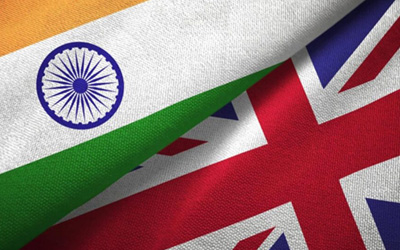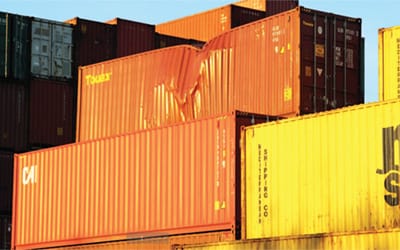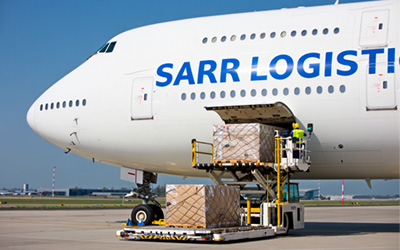Drought Crisis in the Panama Canal: Its Far-Reaching Impact on Global Shipping
The Panama Canal, a crucial waterway connecting the Pacific and Atlantic Oceans, is currently facing a significant crisis due to an ongoing drought. This water scarcity is posing multifaceted challenges, not only to the operations of the canal but also to the global maritime industry.
Exploring the depth of this issue is essential to comprehend its implications on international trade, shipping companies, and economies worldwide. This will prove to be a challenging time over the Christmas period for retailers trying to get stock ready for customers, delays could have an impact on shortages and ultimately bump up prices of presents this year.
Understanding the Drought: Causes and Implications
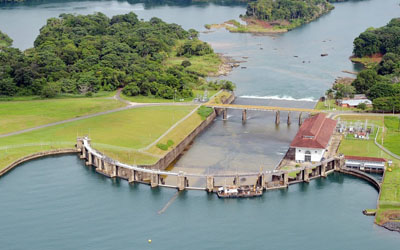 The prevailing drought in the Panama Canal region stems primarily from the El Niño climate pattern. El Niño causes warmer ocean temperatures in the central and eastern Pacific, which disrupts normal weather patterns, leading to decreased rainfall. This climatic phenomenon has resulted in one of the driest periods in Panama’s recorded history, spanning over a century.
The prevailing drought in the Panama Canal region stems primarily from the El Niño climate pattern. El Niño causes warmer ocean temperatures in the central and eastern Pacific, which disrupts normal weather patterns, leading to decreased rainfall. This climatic phenomenon has resulted in one of the driest periods in Panama’s recorded history, spanning over a century.
Rainfall measurements in the vicinity of the canal have plummeted to levels substantially below annual averages, registering a 30-50% reduction. Gatun Lake, the primary reservoir for the canal’s lock system, is experiencing lower-than-expected water levels.
The early onset of Panama’s dry season, coupled with significant evaporation due to elevated temperatures during El Niño events, poses a threat of historic low water levels by the approaching year of 2024.
Impact on Shipping Operations and Maritime Industry
The adverse effects of this drought are significantly impacting container shipping operations. Shipping giants like Maersk have been compelled to adjust their operations due to the reduced water levels. Maersk, among the world’s largest shipping companies, has had to load approximately 2,000 fewer containers than their usual capacity on vessels navigating through the canal.
The imposed water scarcity has led to draft restrictions, mandating a depth limit of 44 feet instead of the usual 50 feet for container ships, thereby necessitating cargo weight reduction or transporting fewer goods to comply.
It’s worth noting that the challenges resulting from climate-related vulnerabilities are not confined solely to the Panama Canal. Other vital waterways, such as the Rhine River in Europe, are also susceptible to low water levels, causing disruptions in shipping and trade across the region.
The Panama Canal is currently facing a significant backlog of vessels, amounting to 154 ships, which has led to a reduced number of available slots for carriers to reserve passage. This backlog, coupled with extended waiting periods of around 21 days for vessels to navigate through the canal, has far-reaching implications for global trade.
The United States, the largest user of the canal, relies on it for approximately 73% of its commodity exports and imports, with nearly 40% of all U.S. container traffic passing through the canal, valuing at an astounding $270 billion worth of cargo.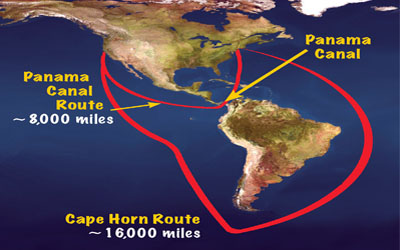
The only alternative is to take a massive detour round the cape of good horn which in it self poses problems and a significant time difference causing longer shipping time, delaying deliveries not to mention the extra fuel costs which in turn will be passed on to consumers which just adds to the cost of living crisis which is already causing many problems across the globe.
Canal Administration's Response and Future Concerns
In response to the crisis, the Panama Canal Authority (ACP) has implemented various measures to conserve water, including reducing vessel draft limits and daily passage authorizations. Despite these efforts, experts’ express concerns about potential disruptions to maritime trade in the coming years, as the current dry period is anticipated to persist and worsen.
The fear of an early onset of Panama’s dry season, combined with higher-than-average temperatures, raises the specter of increased evaporation and near-record-low water levels by 2024.
Additionally, recent reports from Reuters indicate that the Panama Canal Authority has reduced the number of daily transits from 32 to 31, affecting vessel capacities and potentially impacting a broader spectrum of shipping sectors beyond the international maritime industry.
This reduction underscores the growing challenges faced by the canal due to the prolonged drought conditions.
Seeking Solutions and Mitigating the Crisis
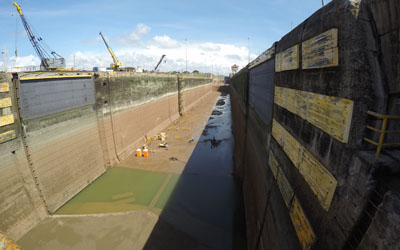 Addressing the ongoing drought in the Panama Canal requires a multi-faceted approach involving regional collaboration, climate-conscious policies, and innovative solutions. Collaborative efforts between nations, scientific institutions, and environmental organizations are crucial in devising sustainable strategies to mitigate the effects of the drought.
Addressing the ongoing drought in the Panama Canal requires a multi-faceted approach involving regional collaboration, climate-conscious policies, and innovative solutions. Collaborative efforts between nations, scientific institutions, and environmental organizations are crucial in devising sustainable strategies to mitigate the effects of the drought.
Implementing advanced water conservation technologies, exploring alternative water sources, and investing in climate-resilient infrastructure are paramount in safeguarding the smooth operation of the canal and sustaining global trade routes. Additionally, raising awareness and advocating for climate change mitigation measures on a global scale are pivotal to prevent similar crises in other critical waterways worldwide.
Conclusion
In conclusion, the drought crisis in the Panama Canal poses imminent challenges to global shipping, trade, and economies. The repercussions of the water scarcity extend far beyond the canal’s confines, affecting shipping operations worldwide.
The urgency to address this crisis is evident, emphasizing the need for concerted efforts to navigate through these challenging times and ensure the resilience of vital maritime trade routes.
By understanding the causes, implications, and potential solutions to the ongoing drought in the Panama Canal, stakeholders can collectively work towards mitigating its impact and securing the uninterrupted flow of global trade and commerce.
This will be a problem for most retailers and any companies reliant on imports that come across our oceans. Which in turn could have an impact on Air freight as people will want to guarantee delivery before Christmas, and we all know what happens then the Air freight prices sore due to the supply and demand economics rule.
Emphasizing the importance of a good freight forwarding logistics company, we have our fingers on the pulse when it comes to maritime news and the best advice for fast shipments to save you the worry of not having enough stock this Christmas.
For details on how to get ahead of your competitors and keep your stocks high get in touch we are always happy to advise you on all your shipping needs. SARR Logistics your goods are safe in our hands.




